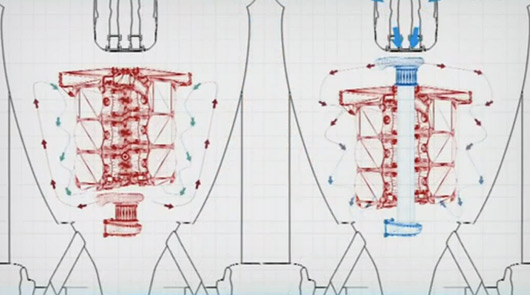The Mercedes AMG F1 W05 has been untouchable so far this season. That’s no surprise, though, because the team dominated pre-season testing and has backed that up by winning the first three races of the year. So what makes the 2014 Silver Arrow so good?
In short, the answer centres around the design of its turbo. Despite what SkySports F1 will tell you this was first discussed by Scarbs back in March. But it’s still worth taking a look at this piece from Sky as described by Martin Brundle.
Looking at the image above the car on the left has a conventional turbo design, while the one on the right, illustrating the W05, shows a split turbo arrangement. The air compressor is placed at the front of the engine where it has better access to cooler air, while the turbine remains at the rear to make use of the exhaust gasses.
The net result of that change is that the turbo is more efficient, it allows for better weight distribution and improved aero packaging at the rear of the car.
So why aren’t all Mercedes-powered cars fighting for race wins? The story we’ve heard is that the customer teams did not get the full details of the new PU 106 A Hybrid V6 power unit until they had signed contracts. Whereas Mercedes AMG was able to develop the W05 from the start with full knowledge of the split turbo design, allowing it to better refine its aero and other packaging.
It’s a simple concept that must be incredibly difficult to implement, otherwise you wonder why nobody else has done it. Moreover, you’d have to think this concept has wider applications beyond motorsport too, into the cars we drive on the streets.
[Thanks to Tiaan for the tip]

4 replies on “Why is the Mercedes AMG F1 W05 so good?”
Amazing in 2014 with all the advanced technology, engineering degrees, monstrous CAD computing power, that no other engine manufacturer or F1 team could up with such a simple concept as Mercedes did to separate the compressor from the turbine. Ingenious!
You can bet ever engine next year will be running the same configuration as the Mercedes engine.
Don’t know how relevant this will be in road cars. It only works on v configuration engines, you need a relatively long, stiff shaft that can handle 100000+ revs. If that shaft is too heavy, the speed won’t build quickly and you’ll get the worst lag. Still, if you can make a titanium pipe to do that, terrific. Kudos to MB AMG!
[…] inspired a little by the innovative turbo configuration from the F1 W05 the M178 V8 features what’s been labelled as “hot inside V” whereby the turbos […]
[…] inspired a little by the innovative turbo configuration from the F1 W05 the M178 V8 features what’s been labelled as “hot inside V†whereby the turbos are mounted […]